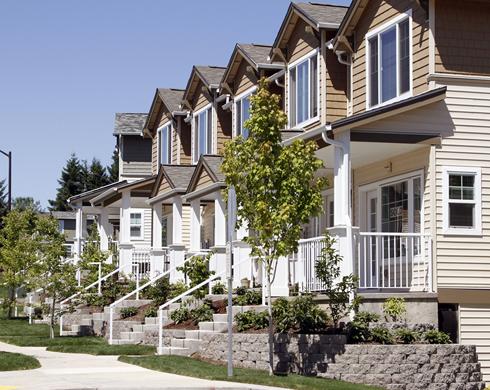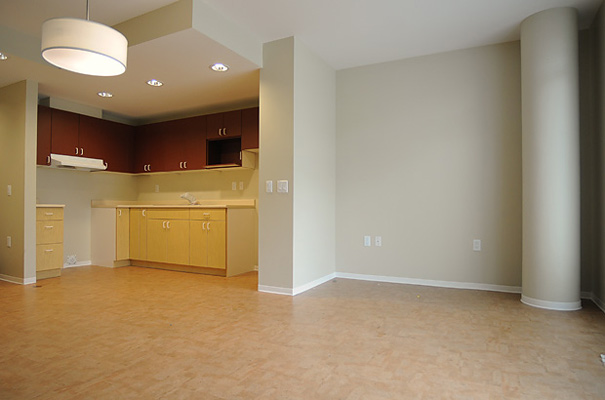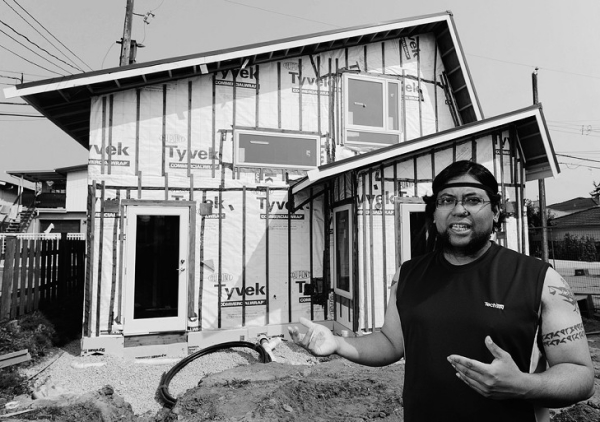Paul Wiseman
USA Today

New townhouses for sale are shown in Beaverton, Ore. By Don Ryan, AP
Just how much should Uncle Sam do to help Americans buy their own homes?
For 70 years — and for the last 15 in particular — the answer has been: Whatever it takes.
Now, policymakers are pausing to reconsider. In the next few months, they’ll weigh whether there can be too much of a good thing when it comes to helping families finance the American Dream.
The rethink could mean a shake-up for a mortgage market addicted to government subsidies.
“This process of figuring out the government’s role is going to involve some hard choices,” says Alyssa Katz, author of Our Lot: How Real Estate Came to Own Us. “The moment you start changing the nature of what is guaranteed by the government, what is subsidized, you start to change the alignment of winners and losers. … We took for granted that anyone could get a mortgage.”
Using guarantees and tax breaks, the government pushed homeownership past 69% in 2004. Then it all came crashing down.
Housing prices started crumbling in 2007, panicking financial markets, forcing the government to seize mortgage giants Fannie Mae and Freddie Mac, and pushing the economy into the worst recession since the 1930s. Homeownership has fallen below 67%.
Now, Washington is preparing to rebuild the national mortgage market atop the ruins of Fannie and Freddie. The proposal, due early next year from the Obama administration, could make it harder to buy a home by reducing available credit or requiring bigger down pay-ments. Low-income renters might get more government help.
Congressional Republicans doubt the administration has the nerve to make bold changes. They say the White House squandered an opportunity to deal with what they see as the No. 1 problem — limiting taxpayer losses on Fannie Mae and Freddie Mac — in an overhaul of financial regulations Congress passed last month. “What you’ve seen is two years of lip service,” says Rep. Spencer Bachus of Alabama, ranking Republican on the House Financial Services Committee. “The administration and the congressional Democrats have not shown any willingness to address the issue other than to talk about it and have planning sessions.”
Other critics say eliminating or overhauling Fannie and Freddie isn’t enough: The government must reconsider such bedrocks of housing policy as the mortgage interest deduction and the tax exemption of most capital gains from home sales.
They say these misguided or outdated government policies encourage the United States to massively overinvest in housing, shortchanging other parts of the economy. “There’s only so much subsidy to go around at the end of the day,” Katz says.
The administration isn’t tipping its hand in advance of a conference next Tuesday on housing finance reform in Washington. But officials insist that big changes are coming to housing finance. Treasury Secretary Timothy Geithner has said the reforms must: continue to make mortgage credit widely available; promote affordable housing for home buyers and renters alike; protect consumers from predatory lending; and promote financial stability.
“We have committed to having a proposal in place by early next year,” says Federal Housing Administration Commissioner David Stevens. “This is not about delaying. This is about being thoughtful.”
Policymakers are moving cautiously because the housing market is on government life support two years after the worst of the financial crisis. “Even today, private capital has not yet fully returned to this market,” Jeffrey Goldstein, the Treasury Department’s undersecretary for domestic finance, wrote recently. “Fannie Mae, Freddie Mac and other government entities guarantee more than 90% of newly originated mortgages. They are practically the only game in town.” (In 2005, they accounted for just a third of the market.)
Square 1: Fannie & Freddie
Whatever Washington does in the next few months will likely focus on Fannie and Freddie.
The housing giants buy mortgages from banks and other lenders. Usually, they package the mortgages into securities and sell them to investors. Sometimes, they keep the mortgages in their own portfolios. The idea: to create a thriving secondary market in mortgages. By selling their mortgages to Fannie and Freddie, banks clear room on their balance sheets to make more loans, ensuring a plentiful supply and making it easier for home buyers to find financing.
Fannie (established by Congress in 1938) and Freddie (1970) were private, profit-seeking companies, but they operated with the implicit understanding that taxpayers would bail them out if they ran into trouble. That assumption gave them access to low-cost financing. They made enormous profits, paid their top executives extravagant salaries and accumulated outsize influence in Washington. They used their clout to lobby for bare-minimum levels of capital to cushion against losses.
Thin capital proved lethal when Fannie and Freddie caught the virus that infected the rest of the financial system in the mid-2000s: irrational exuberance about housing prices. The mortgage giants had strayed from conventional mortgages. In 2000, they held few securities backed by subprime or undocumented Alt-A loans from private lenders; by 2007, those mortgages accounted for nearly a quarter of their portfolios.
When housing prices collapsed, Fannie and Freddie were sitting on huge losses. The government seized the two companies, making explicit Uncle Sam’s implicit guarantee. Geithner says regulators couldn’t just let the mortgage giants fail without risking “devastating consequences for the housing finance system and the broader economy.” The Congressional Budget Office estimates that bailing out Fannie and Freddie will cost taxpayers $389 billion between 2009 and 2019.
Just about everyone agrees that Fannie and Freddie, known as government-sponsored enterprises or GSEs, were built around a fatally flawed model — one in which investors and executives pocketed profits and taxpayers absorbed losses. “After reform, the GSEs will not exist in the same form as they did in the past,” Geithner told Congress in March. “Private gains will no longer be subsidized by public losses.”
House Republicans are calling for Fannie and Freddie to be put out of business within four years. Democrats don’t go that far: “We know we have to replace them,” says Rep. Barney Frank, D-Mass., chairman of the House Financial Services Committee. Whatever supplants Fannie and Freddie in the mortgage business, Frank says, should be either 100% private or 100% public, not a hybrid.
In April, Treasury and the Department of Housing and Urban Development asked various players in the housing market, from lenders to advocates for the homeless, to weigh in on reform proposals. Many call for Fannie and Freddie to be replaced by private firms that enjoy straightforward government support but have a narrower mission and are far more tightly regulated than the failed housing giants.
Tinkering with housing finance is like playing with political dynamite, says Raj Date, executive director of the Cambridge Winter Center for Financial Institutions Policy. Fannie and Freddie “actually do provide a very large subsidy to homeowners who borrow money,” he says. “Here’s the thing about upper-middle-income suburban homeowners: They vote. When you take away a huge housing subsidy, they notice.”
30-year mortgages
One example: Freddie and Fannie, with their government backing, allowed the proliferation of 30-year, fixed-rate mortgages — a product that lenders would otherwise shun. Reason: Long-term, fixed-rate loans struggle in any interest rate scenario. If rates rise, banks are squeezed, because their revenue remains fixed even though they have to pay more for deposits and other funding. If rates fall, homeowners refinance. “No rational market participant is going to bear that risk,” Date says.
Long-term fixed-rate mortgages make sense only if the government is absorbing some of the risk. Reforming housing finance, Date says, could jeopardize the future of long-term, fixed-rate mortgages or raise interest rates on them, perhaps a quarter to half a percentage point.
Even if the government doesn’t make radical changes in the way housing is financed, it likely will shift emphasis away from encouraging homeownership and toward helping low-income families find affordable apartments to rent. “We have to be very pro-homeownership,” Housing Commissioner Stevens says. But “we strongly believe in a balanced housing policy. … Not everybody was prepared to own a home.”
Until now, government policy has been lopsided in favor of putting people into houses of their own. The Congressional Budget Office reports that government subsidies for homeownership, including the mortgage interest deduction, reached $230 billion last year. That compares with $60 billion in tax breaks and federal spending programs supporting the rental market.
A lot of renters could use the help, the CBO says. In 2007, 45% of tenants spent more than 30% of their incomes on shelter — the threshold for affordable housing — compared with 30% of homeowners.
Things are worse for the poorest renters, households earning 30% or less of the median income in their area: The National Low Income Housing Coalition found that 71% of the poorest households spent more than half their income on rent in 2008.
Rent consumes half of Dorotha Allamand’s $1,300 monthly Social Security check. The retired nurses’ aide lives in Gridley, Calif., alone except for her three cats. She’s on a two-year waiting list for Section 8 rental housing assistance and faces a three-year wait for a senior citizens’ housing program. “So here I am, hoping from month to month that I have a roof over my head and enough to eat,” she says.
Sheila Bair, chairman of the Federal Deposit Insurance Corp., asked recently “whether federal policy is devoting sufficient emphasis to the expansion of quality affordable rental housing.” Owning a home, she said, might not work for everybody.
A post-WWII push
Before World War II, would-be home buyers faced huge obstacles. Banks demanded 50% down payments for mortgages that would last just five or six years; then, the homeowners would have to cough up the balance in a balloon payment. Homeownership remained mired around 40%.
Then came government support for homeownership through Fannie, Freddie, the Veterans Administration and the Federal Housing Administration, a government agency that insures mortgages. The new long-term, fixed-rate mortgages, encouraged by Fannie and later Freddie, made housing payments affordable to ordinary families. The mortgage interest deduction, which cost the Treasury $80 billion in 2009 alone, made homeownership even more attractive.
Housing has an enormous impact on the economy: Harvard University‘s Joint Center for Housing Studies reports, for instance, that cutbacks in home building and remodeling slashed a full percentage point off economic growth in 2007 and almost that much in 2008.
But urban studies specialist Richard Florida, author of The Great Reset: How New Ways of Living and Working Drive Post-Crash Prosperity, says that federal programs to promote homeownership don’t make as much economic sense as they used to. When families bought suburban homes after World War II, the benefits rippled throughout the economy: U.S. manufacturers cranked out refrigerators and ovens for the kitchen, televisions and sofas for the living room, dressers and vanities for the bedroom, cars to carry Dad from the suburbs to his office downtown.
“It worked fabulously,” says Florida, a professor at the University of Toronto’s Rotman School of Management. “It really primed the pump of America’s industrial machine.”
These days, not so much: Appliances and furniture usually aren’t Made-In-America anymore. Neither, increasingly, are cars. A housing boom doesn’t deliver the bang for the buck that it used to, Florida argues.
High homeownership rates also impose economic costs. They lock workers into houses that can be tough to sell, especially in recessions, so it’s harder for them to move to find new jobs. The percentage of Americans changing addresses hit a record low 11.9% in 2008 before bouncing up a bit last year; the so-called moving rate exceeded 20% as recently as 1985.
Florida has found that U.S. cities with high homeownership rates tend to lag behind other cities in job creation and earnings. He argues that the government should nudge the homeownership rate lower, perhaps to around 55%, by cutting the subsidies that prop it up.
Would anyone in Washington risk political hara-kiri by killing housing subsidies to the middle class?
“What really causes the decline of nations is when they become sclerotic, when they get locked into public policy approaches that don’t work,” Florida says. “I’m an optimist. … We have reinvented ourselves before.”
But for now, he says, “Everybody is talking around the problem. We need to wake up.”












